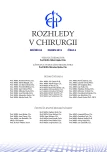Massive small intestine bleeding: CT-angiography and surgical treatment – a case report
Authors:
J. Halamka 1; P. Chmátal 2
Authors‘ workplace:
Chirurgické oddělení Městské nemocnice v Litoměřicích, primář: MUDr. L. Dostál
1; Ústav leteckého zdravotnictví Praha, ředitel: MUDr. P. Chmátal Ph. D., MBA
2
Published in:
Rozhl. Chir., 2015, roč. 94, č. 4, s. 174-176.
Category:
Case Report
Overview
Gastrointestinal bleeding is one of acute abdomen conditions that occur relatively frequently. Most cases can nowadays be managed endoscopically, surgery is rarely required. Approximately 5% of gastrointestinal bleeding cases are cases of so-called obscure gastrointestinal bleeding. The presented massive gastrointestinal bleed case report provides a current view on diagnostic and therapeutic modalities in the context of everyday clinical practice.
Key words:
angiectasia – obscure gastrointestinal bleeding – lower gastrointestinal bleeding – CT-angiography
Sources
1. Pastor J, Adámek S. Obskurní krvácení do zažívacího traktu. Rozhl Chir 2013;92:424−8.
2. Imdahl A, et al. Genesis and pathophysiology of lower gastrointestinal bleeding. Langenbecks Arch Surg 2001;386:1−7.
3. Manning-Dimmitt LL, Dimmit SG, Wilson GR. Diagnosis of gastrointestinal bleeding in adults. Am Fam Physician 2005;71:1339−48.
4. Zink SI, Ohki SK, Stein B, et al. Noninvasive evaluation of active lower gastrointestinal bleeding: a prospective study. J Med Imaging Radiat Oncol 2011;55:252−8.
5. Martí M, Artigas JM, Garson G, et al. Acute lower intestinal bleeding: feasibility and diagnostic performance of CT angiography. Radiology 2012;262:109−16.
6. Kochhar GS, Sanaka MR, Vargo JJ. Therapeutic management options for patients with obscure gastrointestinal bleeding. Ther Adv Gastrenterol 2012;5:71−81
7. Czymek R, Kempf A, Roblick UJ, et al. Surgical treatment concepts for acute lower gastrointestinal bleeding. J Gastrointest Surg 2008;12:2212−20.
8. Garcia-Blásquez V, Vicente –Bártulos A, Olavarria-Delgado A, et al. Accuracy of CT angiography in the diagnosis of acute gastrointestinal bleeding: systematic review and meta-analysis. Eur Radiol 2013;23:1181−90.
9. Longstreth GF. Epidemiology and outcome of patients hospitalized with acute lower gastrointestinal hemorrhagy: a population – based study. Am J Gastroenterol 1997;92:416−23.
10. Wu LM, Xu JR, Yin Y, et al.Usefulness of CT angiography in diagnosing acute gastrointestinal bleeding: a meta-analysis. World J Gastronetrol 2010;31:3957−63.
11. Ríos A, Montoya MJ, Rodzíguez JM, et al. Severe acute gastrointestinal bleeding: risk factors for morbidity and mortality. Langenbecks Arch Surg 2007; 392: 165−1.
12. Ghassemi KA, Jensen DM. Lower GI bleeding: epidemiology and management. Curr Gastroenterol Rep 2013;15:333.
13. Dayer C, Chino A, Lucas C. Acute lower gastrointestinal bleeding in1 112 patients admitted to an urban emergency medical center. Surgery 2009;146:600−6.
14. Vernava AD, Moore BA, Longo WE, et al. Lower gastrointestinal bleeding. Dis Colon Rectum 1997;40:846−58.
15. Cohn SM, Moller BA, Zieg PM, et al. Angiography for preoperative evaluation in patients with lower gastrointestinal bleeding: are the benefits worth the risks? Arch Surg 1998;133:50−5.
16. Ševčík P, Matějovič M, Černý V, et al. Intenzivní medicína. Galén, Praha 2014: 242−5,525−37.
Labels
Surgery Orthopaedics Trauma surgeryArticle was published in
Perspectives in Surgery

2015 Issue 4
Most read in this issue
- The ONSTEP inguinal hernia repair technique
- Massive small intestine bleeding: CT-angiography and surgical treatment – a case report
- Acute necrotizing pancreatitis: traditional laparotomy vs. minimally invasive procedures
- The past and present of thumb reconstruction
